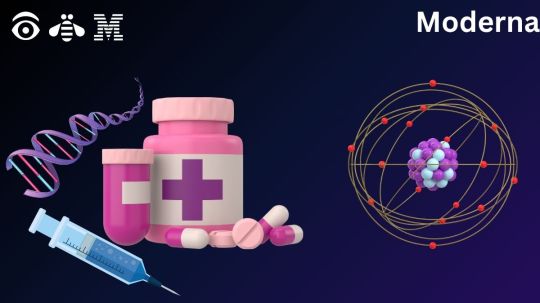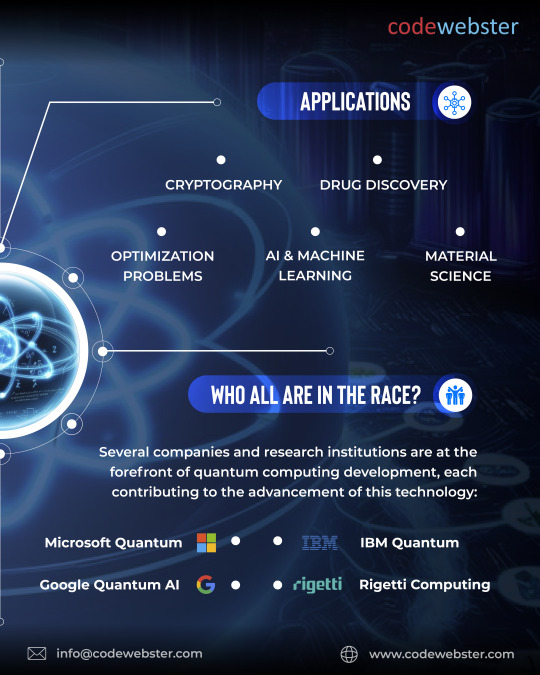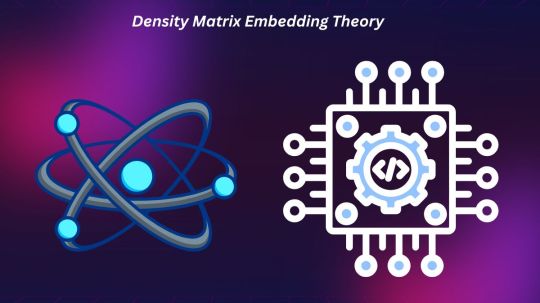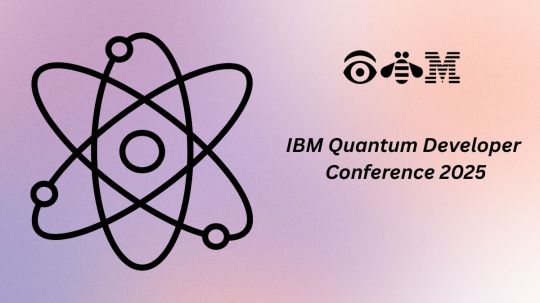#IBMQuantum
Explore tagged Tumblr posts
Text
Moderna and IBM Quantum in Drug Discovery mRNA Modelling

IBM, Moderna
Moderna and IBM Quantum Improve mRNA Modelling, Readying New Drugs
An innovative relationship between IBM Quantum and Moderna is advancing drug discovery by leveraging quantum computing to solve mRNA medical difficulties. This collaboration resulted in the largest and most advanced quantum variational execution for protein secondary structure simulation.
Quantum Computing for mRNA Science
Moderna, a leading mRNA medication and vaccine maker, is reviewing quantum computing to improve its life-saving drugs. RNA molecules tell cells to generate proteins that prevent or treat diseases. Traditional computers are good for mRNA development, but they cannot solve the computationally intensive problems of discovering effective mRNA combinations. There are “astronomically large number of possible mRNA sequences” for any protein, making optimisation difficult.
According to Alexey Galda, Associate Scientific Director, Quantum Algorithms and Applications at Moderna, which aims to improve human health, it is “critical to explore every available tool, including quantum computing, to scale the progress, rather than wait for the technology to fully mature in the Their proactive attitude has helped them learn quantum computing since the technology is on the "threshold of useful applications."
New mRNA structure prediction breakthrough
Drug discovery based on mRNA molecules requires knowledge of their secondary structure, especially the complicated folding patterns caused by internal nucleotide attractions. These structures regulate mRNA translation into proteins based on stability, cellular machinery interaction, and efficiency. The combinatorial optimisation challenge of anticipating this structure is ideal for quantum-enhanced algorithms.
The Moderna-IBM team employed CVaR-based VQA efficiently to solve this problem. Using CVaR, a risk-assessment tool used in banking, to focus the optimisation process on the most promising, lowest-energy options has improved Variational Quantum Algorithms (VQAs). By focussing on high-quality measurement findings with minimum computational cost, this technique reduces noise in the noisy intermediate-scale quantum (NISQ) era.
The IBM Quantum Heron chip's 80 qubits were utilised to quantum mimic a 60-nucleotide mRNA sequence in 2024, setting a record. The authors believe no quantum computer has ever mimicked 42-nucleotide sequences. Later 2025 work will apply this approach to 156-qubit problems. This study will investigate instantaneous quantum polynomial (IQP) circuit-based quantum optimisation.
Zukunft und Quantum Utility
This collaboration shows the quantum community's progress towards quantum advantage, when quantum computers outperform classical computers for specific tasks. Jay Gambetta, IBM's Vice President of Quantum, believes quantum advantage will arrive by 2026, emphasising the importance of improving heuristic approaches, as Moderna and IBM have proved.
In contrast to replacing classical computers, Moderna's goal is to quickly establish a quantum-enabled biotechnology pipeline. According to Alexey Galda, quantum technologies can provide a “more diverse set of solutions” and molecules to test, making them “extremely valuable for the computational problems that are core bottlenecks in the workflow”. Quantum will “augment the classical computation and offer certain advantages in certain areas.” The most likely result.
Moderna Senior Vice President, Digital Wade Davis underlined the need of early adoption and strategic cooperation to grasp new technology on its terms rather than playing catch-up. Working with IBM allowed us to glimpse what this quantum approach could do before it appeared and we had to race to understand it. As the company grows, Moderna aims to leverage quantum computing to maximise mRNA treatments.
#ModernaandIBM#quantumtechnology#ibm#quantumcomputing#IBMQuantum#couldaccomplish#mRNAScience#mRNAdevelopment#technology#technews#news#govindhtech
0 notes
Text
How Quantum Computing Will Make Your Computer Look ANCIENT
youtube
Quantum computing is the future! Find out why Google and IBM are racing to change the world with this revolutionary technology. The future is quantum, and it will make your current computer look ancient. Find out more about this cutting-edge tech in this video!
#quantumcomputing#googlequantum#ibmquantum#futuretech#quantumrevolution#techinnovation#aiandquantum#superposition#quantumrace#quantumfuture#quantumencryption#googlevsibm#quantumexplained#Youtube
0 notes
Text
Quantum Computing for Everyday Use: How It Will Change Your Life!
Quantum computing is no longer just a futuristic concept—it’s becoming a reality! 🌍🚀 From revolutionizing drug discovery and cryptography to optimizing supply chains and enhancing artificial intelligence, quantum computers are set to transform industries and impact our daily lives. In this video, we explore how companies like IBM and Google are bringing quantum technology closer to mainstream adoption. 🔬 Discover how quantum computing is solving real-world problems 🔑 Learn about the impact on cybersecurity and financial markets 🌎 See how quantum tech is helping in climate modeling and AI Don’t forget to LIKE 👍, SUBSCRIBE 🔔, and SHARE 📢 to stay updated on the latest tech innovations!
youtube
#QuantumComputing#Technology#AI#FutureTech#IBMQuantum#GoogleQuantum#QuantumRevolution#TechTrends#MachineLearning#Cybersecurity#BigData#QuantumAI#Innovation#Science#TechNews#ArtificialIntelligence#DeepLearning#Cryptography#SpaceExploration#QuantumBreakthroughs#Youtube
0 notes
Link
#Googlequantumsupremacy#IBMquantum#latestquantumresearch#Microsoftquantum#post-quantumcryptography#quantumAI#quantumcomputing
0 notes
Text
Top 9 Software Development Trends for 202
Welcome to our blog, your go-to source for exploring the most significant software development trends of 2024. In an ever-evolving tech landscape, staying ahead of the curve is crucial for professionals and businesses alike. Our blog provides an in-depth analysis of the latest advancements, including generative AI, quantum computing, edge computing, and more. We aim to shed light on emerging technologies and industry shifts that could impact your development practices and strategic decisions.
By diving into topics such as low-code/no-code platforms, green IT practices, and the latest in cybersecurity, we offer valuable insights and practical guidance to help you navigate and leverage these trends effectively. Whether you’re looking to enhance your development processes, embrace new technologies, or understand the implications of these advancements, our blog is here to keep you informed and prepared.
🔗 Read the full article to dive deeper into these trends and understand their impact on your work and business.
Stay ahead of the curve and explore how these trends can drive growth and efficiency in the tech world. 🚀
#softwaredevelopment#TechTrends#AI#EdgeComputing#Blockchain#Sustainability#5G#6G#UserExperience#Innovation#Connectivity#TechTrends2024#LowCodeNoCode#GreenIT#RemoteWork#TechInnovation#ITTrends#ProgressiveWebApps#AugmentedReality#VirtualReality#DigitalTransformation#TechInsights#FutureOfTech#AIDevelopment#GPT4#CodeGeneration#AIInTech#IBMQuantum#GitHubCopilot#OpenAICodex
0 notes
Text


𝗤𝘂𝗮𝗻𝘁𝘂𝗺 𝗖𝗼𝗺𝗽𝘂𝘁𝗶𝗻𝗴: 𝗧𝗵𝗲 𝗙𝘂𝘁𝘂𝗿𝗲 𝗶𝘀 𝗡𝗼𝘄! ⚛️💻 Quantum computing is reshaping the future! Unlike traditional computers, quantum machines use qubits to solve complex problems at unimaginable speeds. From AI advancements 🤖 to drug discovery 💊, finance 📈, and cybersecurity 🔐, the impact is massive! Big tech giants like Microsoft, IBM, Google, and Rigetti are leading the way—are we ready for the Quantum Revolution? Let’s discuss! 👇 #QuantumComputing #TechRevolution #AI #NextGenTech #QuantumLeap #DigitalTransformation #Innovation #MicrosoftQuantum #IBMQuantum #GoogleQuantumAI #RigettiQuantum #Codewebster #F2F #USA #Viral #Follow4Follow #NYC #TechTrends #ElonMusk #OpenAI
0 notes
Text

Breakthrough in Quantum Computing: IBM's Eagle Processor
IBM recently unveiled a significant leap in quantum computing with its 127-qubit "Eagle" processor, marking a substantial technical milestone. Unlike traditional computers that use bits as 0s and 1s, quantum computers operate on qubits, which can exist in multiple states simultaneously, thanks to superposition. The Eagle processor surpasses the 100-qubit barrier, making it the most powerful quantum chip to date.
This leap brings us closer to quantum supremacy, where quantum machines can solve problems in seconds that would take classical computers thousands of years. IBM’s Eagle uses advanced architecture to reduce quantum errors, a major challenge in the field, and demonstrates an unprecedented capability to simulate complex molecules, which could revolutionize fields like drug discovery, cryptography, and artificial intelligence.
IBM aims to integrate this processor into its Quantum System One, offering cloud-based access for enterprises looking to harness quantum power. This development places quantum computing on the verge of real-world applications, promising breakthroughs in optimization problems, cryptographic systems, and AI training. https://www.knowledgewale.com/search/label/Technology
#quantumcomputing #ibmeagleprocessor #quantumbreakthrough #quantumtechnology #ibmquantum #eagleprocessor #quantumadvancements #quantumcomputingnews #quantuminnovation #quantumcomputing2024 #ibmresearch #quantumalgorithms #quantumchip #futureofcomputing #quantumhardware #highperformancecomputing #quantumleaps #quantumapplications #quantumresearch #quantumcomputers
0 notes
Photo

The future of computers is here! “The IBM quantum computer!”... And I still feel like music software plug-ins will take this down to its knees! #summertryouts #ibmquantum #quantum #quantumcomputing #quantumcomputer #electronic #undergroundmusic #dreamwave #housemusic #daw #vaporwaves #techno #aesthetic #cyberpunk #cyberwave #spotify #spotifyplaylist #art #neonlights #neon #electronicmusicartist #tokyo #photooftheday #lofi #aesthetictumblr #soundcloud #chill #chillmusic #chilloutmusic https://www.instagram.com/p/BsYF7jlHdMY/?utm_source=ig_tumblr_share&igshid=m6ryox3jq88d
#summertryouts#ibmquantum#quantum#quantumcomputing#quantumcomputer#electronic#undergroundmusic#dreamwave#housemusic#daw#vaporwaves#techno#aesthetic#cyberpunk#cyberwave#spotify#spotifyplaylist#art#neonlights#neon#electronicmusicartist#tokyo#photooftheday#lofi#aesthetictumblr#soundcloud#chill#chillmusic#chilloutmusic
0 notes
Text
IBM quantum computing
https://www.ibm.com/quantum-computing/
https://www.ibm.com/blogs/research/tag/ibm-quantum/
https://www.ibm.com/blogs/research/2020/08/q2work-quantum-education/
https://www.ibm.com/blogs/research/2020/09/hardware-aware-quantum/
https://www.ibm.com/blogs/research/2020/07/future-quantum-workforce/
https://www.ibm.com/blogs/research/2020/09/2021-ibmquantum-internships/
https://www.ibm.com/blogs/research/2020/09/quantum-industry/
https://www.ibm.com/blogs/research/2020/10/quantum-coding-school/
https://www.ibm.com/blogs/research/2020/08/quantum-research-centers/
https://www.fondazionecrui.it/
0 notes
Text
Density Matrix Embedding Theory & SQD for Quantum Modelling

Density Matrix Embed Theory
Combining Quantum Simulation Methods to Address Complex Molecules for Medical Progress
Michigan State University, IBM Quantum, and the Cleveland Clinic proved that hybrid quantum-classical techniques can accurately represent complex molecules using quantum computers, a major quantum chemistry breakthrough. Combining Density Matrix Embedding Theory (DMET) and Sample Based Quantum Diagonalisation (SQD), this groundbreaking finding advances quantum-centric scientific computing and has major health and medical implications.
Unlocked with Hybrid Quantum-Classical Power
Even the most advanced supercomputers have struggled to simulate huge molecule stability and behaviour, which is crucial for disease understanding and treatment. Modern high-performance computers cannot track over 33,000 molecular orbitals, which is needed to simulate insulin. Classical techniques fail as molecules increase larger. In addition, classical mean-field approximations fail to capture crucial electron interactions.
The first implementation of the SQD algorithm on genuine quantum hardware and incorporation into the Density Matrix Embedding Theory framework in this paper offers hope. This unique method, DMET-SQD, could replicate hydrogen rings and cyclohexane conformers. The DMET-SQD method replicates chemically important sections of a molecule instead than the entire molecule, which would need thousands of qubits. These fragments are then combined into an approximate electronic environment.
Quantum-centric supercomputing (QCSC) is defined by this “division of labour” between quantum and classical resources. The quantum processor in QCSC does the most computationally difficult operations, while regular high-performance computers handle the rest, including error correction. This hybrid technique allows state-of-the-art quantum computers without error-correcting capabilities to handle larger and more chemically realistic molecules. The Cleveland Clinic's IBM-managed quantum device, IBM Cleveland, the first of its type in the US, used 27 to 32 qubits in the study.
Real-World Accuracy Benchmarking
The researchers employed DMET-SQD to critically assess their hybrid technique on a ring of 18 hydrogen atoms and different cyclohexane conformers. Hydrogen rings are a standard benchmark in computational chemistry due to their high electron correlation effects, while cyclohexane conformers (chair, boat, half-chair, and twist-boat) are common in organic chemistry due to their narrow energy range, which makes them sensitive to even small computational
Heat-Bath Configuration Interaction (HCI), which may approach exact solutions, and Coupled Cluster Singles and Doubles with perturbative triples [CCSD(T)] were compared to quantum-classical results. The results were promising: DMET-SQD energy differences across cyclohexane conformers were within 1 kcal/mol of the best conventional reference methods, a standard chemical accuracy criterion.
For sufficiently large quantum configuration samples (8,000–10,000), DMET-SQD met HCI benchmarks for the hydrogen ring with negligible deviation while retaining cyclohexane conformer energy ordering. These results demonstrate that the technique may properly model physiologically relevant molecules despite hardware limitations.
Noisy Quantum Hardware Engineering Solutions
Practical usage of this embedding strategy on quantum technologies distinguishes the study. Modern quantum devices are noisy and unreliable. However, SQD's noise tolerance considerably reduced common errors. The authors stabilised calculations on IBM's Eagle processor via gate whirling and dynamical decoupling.
The team designed a custom interface to connect Tangelo's Density Matrix Embedding Theory library to Qiskit's SQD implementation. The simulation uses Hartree-Fock configurations encoded by each quantum circuit to maintain particle number and spin characteristics. These configurations were refined using S-CORE.
Future Outlook and Major Implications
Although the DMET-SQD technique is revolutionary, it has limitations and is still in its infancy. The fragment size and quantum sampling quality affect simulation accuracy. In systems with small energy changes or considerable electrical correlation, poor sampling may cause irregular energy ordering. The present study used a minimum basis set; chemically relevant applications will require more complex basis sets, qubits, and error control.
Study authors say more work is needed to improve sampling and reduce standard post-processing computer demand. Quantum hardware improvements in error rates and gate integrity will be crucial to scaling and enhancing these simulations.
This work suggests that hybrid quantum-classical approaches can handle real chemical processes better than “toy models.” Breaking full-molecule simulations into quantum computer-solvable subproblems allows scientists to solve previously intractable drug development and materials science problems.
Lead author Kenneth Merz, PhD, of the Cleveland Clinic, said, “This is a groundbreaking step in computational research that demonstrates how near-term quantum computers can advance biomedical research.” If they grow, DMET-SQD or similar hybrid techniques may anticipate novel materials, reaction mechanisms, and protein-drug interactions by accurately describing quantum effects in huge molecules. This breakthrough launches a new age of computational study that will directly help disease diagnosis and therapy.
#IBMQuantum#DensityMatrixEmbeddingTheory#quantumcentricsupercomputing#ibm#news#quantumhardware#hybridquantum#DMETSQD#technology#technews#govindhtech
0 notes
Text
RT @IBM: ICYMI: from #IBMQuantum to blockchain, learn about the major moments of #CES2020 https://t.co/U6fVDRpOuW https://t.co/bsKppU52Ze
ICYMI: from #IBMQuantum to blockchain, learn about the major moments of #CES2020 https://t.co/U6fVDRpOuW pic.twitter.com/bsKppU52Ze
— IBM (@IBM) January 10, 2020
from Twitter https://twitter.com/Ross_Radev
0 notes
Text
How Quantum Computing Will Make Your Computer Look ANCIENT
youtube
Quantum computing is the future! Find out why Google and IBM are racing to change the world with this revolutionary technology. The future is quantum, and it will make your current computer look ancient. Find out more about this cutting-edge tech in this video!
0 notes
Text
IBM Qiskit Functions Templates Advances Quantum Research

New open-source technologies make cutting-edge quantum techniques more accessible and speed research.
IBM Qiskit Functions
IBM Quantum has released Qiskit Function templates, a cutting-edge set of realistic, open-source code examples to accelerate quantum application development and make advanced research more accessible to the quantum community. These templates provide modular pipelines for generating high-quality, reusable quantum operations to turn new academic research into useful, generally applicable applications.
Many creative heterogeneous processes that leverage elastic classical and quantum computing resources have been reported in academic journals but mostly ignored by the public. Qiskit Function templates will change this paradigm by allowing more researchers and developers to instantly benefit from breakthrough quantum techniques.
What Are Qiskit Functions Templates?
Qiskit Function templates, an open-source set of code samples, guide utility-scale application workflows with Qiskit SDK and addons. Customers can easily swap between tools, techniques, and configurations for their own research with their modular pipeline. They must be deployable to Qiskit Serverless, which streamlines operations and parallelises some tasks to integrate traditional computing resources. Premium and Flex Plan customers can use IBM's hosted service or deploy serverless packages in their preferred cloud environment.
Two template types serve diverse roles in quantum development ecology:
Function template implementations: These highly specialised code samples imitate cutting-edge approaches from physics and chemistry studies. They simplify applying cutting-edge techniques like sample-based quantum diagonalisation (SQD) to a range of use cases by merging workflow components into a reusable framework with logs and mid-experiment checkpoints.
Basic templates: These generic code samples demonstrate Qiskit function structure. By demonstrating best practices for interface building, code formatting, and unit testing, they help developers create their own Qiskit functions faster. Two base templates are available: application and circuit.
Making Cutting-Edge Research Happen: Cleveland Clinic Collaboration
The SQD IEF-PCM Qiskit Function template, produced with the Cleveland Clinic IBM Discovery Accelerator, exemplifies function template benefits. Early this year, Cleveland Clinic researchers released a promising new workflow for electronic structure computations, which are vital for biochemical and medicinal applications. That approach is immediately transferred using this template.
The method uses Sample-based Quantum Dynamics. Diagonalisation, a powerful simulation method that uses both quantum and conventional high-performance computing (HPC) platforms, is integrated with IEF-PCM, a common quantum chemistry model for molecular systems in liquids. In June, Cleveland Clinic researchers simulated methanol, methylamine, water, and ethanol using this methodology with IBM Quantum Heron QPUs. They created active gaps of up to 23 orbitals, which might take months or years for other researchers to replicate.
In appreciation of the massive effort required, the Cleveland Clinic researchers and IBM created the SQD IEF-PCM Qiskit Functions template, which builds on the SQD Qiskit addon. This partnership ensures that their advanced SQD approach can be used, tailored, and applied by the public to novel research issues, especially solute-solvent interactions in electronic structure simulations.
Using Qiskit Function Templates
These templates are meant to be simple and effective. Users load templates like sqd_pcm_entrypoint.py for SQD IEF-PCM into Qiskit Serverless after downloading and customising them. After authenticating with qiskit-ibm-catalog, instantiate a QiskitFunction object to define and publish the custom function to Qiskit Serverless.
After uploading the template, users can remotely execute it to define solvent, molecule, and other simulation settings. Users can check logs and monitor program status while running and add print() instructions for real-time metadata. Users can reuse the SQD technique for further IBM Quantum hardware tests because the results are easily retrievable.
Fast-tracking quantum computing fault tolerance
Qiskit Function templates are more than code samples—they democratise quantum computing and advance science. By providing modular, reusable, and deployable methods, they let researchers focus on their scientific problems instead of reinventing fundamental code.
This project supports IBM's objective of global quantum computing and producing a large-scale, fault-tolerant quantum computer by 2029. IBM offers powerful quantum computers and the Qiskit SDK, the industry standard for practical quantum computing. Qiskit Function templates enable access to cutting-edge research and create an open-source, collaborative environment that fosters scientific creativity and discovery.
IBM invites developers and researchers to try these templates. They can improve community resources by constructing and contributing their own specialised tools to the repository, customising GitHub templates for their applications, or attending the Qiskit Function templates webinar. See Qiskit SQD and AQC-Tensor addons for details. These modular software components can scale or develop quantum algorithms.
Qiskit Function templates, which turn published research into helpful tools for the international quantum community, are a major step towards making quantum computing feasible and widely used.
#IBMQiskitFunctions#IBMQuantum#QiskitSDK#quantumcomputing#QuantumDynamics#Qiskit#quantumalgorithms#News#Technews#Technology#Technologynews#Technologytrends#Govindhtech
0 notes
Text
Quantum Crypto News: $8.6B Bitcoin Whale Movement Debates

Quantum crypto news
The Bitcoin whale's $8 billion move shows escalating quantum crypto fears.
A long-dormant Bitcoin whale shifted 80,000 BTC, worth $8.6 billion, from obsolete wallets to more secure addresses, shocking the cryptocurrency world. The “largest daily movement of coins aged 10 years or more in history,” this massive movement has led to considerable speculation that quantum computing's existential danger, not market activity, drove it.
The Whale Awakens: Security Upgrade
Eight Satoshi-era wallets with 80,000 Bitcoin had not been utilised since 2011. Ledger and Arkham CTO Charles Guillemet confirmed that the coins were transferred to modern SegWit (bc1q-style) addresses rather than exchanges. Modern addresses offer higher security and lower transaction fees than the earlier P2PKH (Pay to PubKey Hash) standard used by early wallets. The money's inactivity in their new addresses suggests that the owner, one of the earliest Bitcoin users, prefers to keep rather than sell. At $108,000 per Bitcoin, the transferred value exceeded $8.6 billion.
A recent wave of OP_RETURN messages reached legacy wallets, making the transfer intriguing. These blockchain-embedded notes contained “legal-style notices” claiming coin ownership and offered owners until September 30, 2025, to prove possession via an on-chain transaction using their private keys. Guillemet explained that since the sender never exhibited control of the private keys, these were likely spam, despite initial suspicions of a complicated attack. This event may have prompted the rightful owner to shift the money to a safer format. The sender appeared to be using “adverse possession” as a legal strategy.
Quantum Risks to Cryptocurrency: “Q-Day”
Analysts say this whale's precautions indicate to a greater threat: quantum computing's relentless development. Cryptographers have long cautioned that quantum computers are growing swiftly and could challenge the mathematical foundations of modern digital security. Elliptic curve cryptography is utilised by most cryptocurrencies, including Bitcoin. If quantum computers can reveal private keys behind public wallet addresses, widespread theft may be possible.
This vital time, known as “Q-Day,” may come sooner than expected, say experts. IBM Quantum Vice President Jay Gambetta has stated that “Harvest Now, Decrypt Later” attacks are underway. This suggests that bad actors are collecting encrypted data, such as wallet addresses holding billions of dollars in cryptocurrency, to decrypt when quantum technology progresses.
Industry-wide vulnerability and institutional awareness
The threat is spreading beyond bitcoin. Since BlackRock mentioned quantum computing as a risk factor in its Bitcoin ETF application in May 2025, institutional investors are paying closer attention. Researchers found that 4 million Bitcoin, 25% of the entire supply, are stored in antiquated address forms that are vulnerable to quantum attacks.
Impact is significant. Vitalik Buterin, Ethereum's co-founder, has suggested an emergency hard fork to switch to quantum-resistant cryptography. According to experts at the University of Kent, upgrading Bitcoin may need more than 75 days of network disruptions, which might block the network and trigger market upheaval. Bitcoin mining can be taken over by a nation-state or private entity with a powerful quantum computer, solidifying authority and jeopardising the decentralised ethos of the cryptocurrency system.
Signal to Market
This whale's move suggests that quantum threat is “creeping closer to the Centre of investment strategy,” notwithstanding its marginal status. Long-time holders migrating to more secure wallet types in anticipation for quantum vulnerabilities highlights the need for retail and institutional investors to rethink their security. Unlike price adjustments, which the bitcoin market can recover from, a quantum-driven cryptography flaw would irreparably damage trust.
Despite being billed as a sophisticated security update rather than a selling objective, the transfer has sparked market speculation. No direct institutional or liquidity implications have been observed, and market reactions are limited. This incident emphasises the need of users maintaining current storage systems and developers anticipating computer power and cryptanalytic methods. This technological problem may lead to a rethink of digital property and new security standards for older wallets
#Quantumcrypto#cryptocurrency#blockchain#quantumcomputing#transaction#IBMQuantum#Ellipticcurvecryptography#Bitcoin#News#Technews#Technology#Technologynews#Technologytrends#Govindhtech
0 notes
Text
IBM Quantum Releases Qiskit SDK v2.1 for Quantum Advantage

IBM Quantum's Qiskit SDK v2.1 improves performance and enables quantum advantage demonstration quickly. With an emphasis on improving Qiskit SDK C API support, the release emphasises HPC and quantum community interaction. This innovation enables embedding Qiskit into high-performance computing (HPC) experiments easier and more flexible because C, unlike Python, has extensive interchange with other HPC programming languages like C++ and Fortran.
Key changes in Qiskit SDK v2.1 include
Extended C API support: Developers can directly design quantum circuits and targets using a C API, improving circuit-building time. We want to support full C workflows.
Transpiler improvements: Preset pass managers now recognise discrete Clifford+T bases automatically.
Enhancements to synthesis methods minimise circuit depth, gate counts, and resource usage.
Multi-controlled gate tools: New synthesis algorithms and plugins increase flexibility.
The box instruction now supports stretch durations and custom annotations for more expressive timing control.
Quantum Circuit design in C: Qiskit v2.1's extended C API supports direct quantum circuit design in C. Mixing C and Python speeds circuit building by 10-20 times for a 1000-qubit GHZ state compared to pure Python. C API supports Qiskit gates and instructions like measure, delay, reset, barrier, and Unitary Gate for circuit design. To work with Qiskit's transpiler, visualisation tools, and runtime integrations, qk_circuit_to_python() can convert C circuits to Python.
Clifford+T Target Transpiler Support: The generate_preset_pass_manager() method now automatically checks that the target basis is fully Clifford and T gates. It generates a pass manager to break circuits discretely. To overcome decomposing limits, the pass manager now uses the BasisTranslator pass with Solovay-Kitaev decomposition to simulate single-qubit rotations utilising H, T, and Tdg gates. Transpilation may fail if the Clifford+T basis gate set is not universal. Excluding the S-gate may create pairs of T-gates.
Improved Synthesis Algorithms: Qiskit SDK v2.1 improves circuit synthesis performance for multi-controlled operations and Clifford+T basis set decomposition. The Solovay-Kitaev decomposition transpiler pass runs 100x faster after converting to Rust.
After adding the BoxOp instruction in Qiskit SDK v2.0, Qiskit v2.1 includes box annotations and stretch delays. Annotations allow users to annotate boxes with specific data for later stages of the execution stack or custom transpiler passes, allowing the circuit constructor to communicate intent about a circuit area. Boxes may now accommodate stretch variable durations for more accurate timing.
Upgrades and Deprecations
Users must upgrade to Python v3.10 or later since Qiskit SDK v2.3 will no longer support Python v3.9.
Refactoring the circuit library: Operations are now classed as Instruction or Gate objects (specified by action) or QuantumCircuit objects returned by generic Python functions (defined by structure), continuing Qiskit v1.3's refactoring. Several QuantumCircuit subclasses are officially deprecated, with n_local() for TwoLocal and QFTGate for QFT as alternatives.
Dependencies SymEngine and SymPy are now optional: Qiskit SDK v2.1's Rust-based symbolic math library for the Parameter Expression class eliminates the need for SymEngine and SymPy. They are optional for desterilizing older QPY formats and some visualisation methods.
Qiskit SDK v1.x users should upgrade to v1.4. Users have time to upgrade to the v2.x series with security support until March 2026 and bugfix support until September.
#QiskitSDKv21#IBMQuantum#Python#highperformancecomputing#quantumcircuits#QiskitSDKv20#News#Technews#Technology#Technologynews#Technologytrends#Govindhtech
0 notes
Text
Registration Open for IBM Quantum Developer Conference 2025

Quantum Developer Conference
Apply today for the 2025 IBM Quantum Developer Conference.
IBM Quantum Developer Conference 2025 will be held in Atlanta, Georgia, November 11–14, 2025. This second-annual conference brings together quantum developers, academics, and community leaders to showcase IBM's quantum hardware and software, including as the Nighthawk and Loon processors and Qiskit SDK. Network with experts, watch demonstrations, and discover error-prevention techniques. Conference applications are due September 19, 2025, however space is limited. Active Qiskit users and quantum professionals should use it. The entire community will have access to recordings and event materials if you can't attend. As developers, researchers, and quantum professionals from around the world prepare for the second-annual IBM Quantum Developer Conference (QDC) 2025, the quantum community becomes excited. The conference will be held November 12–14, 2025, at the Hyatt Regency Atlanta, with a welcome reception on November 11. This invitation-only webinar will reveal the software and hardware breakthroughs that will power IBM quantum computers' initial quantum advantage demonstrations. Quantum Advantage Through Collaboration Quantum Developer Conference 2025 is on the imminence of "quantum advantage," when quantum computers may solve problems more precisely, inexpensively, or effectively than traditional computation. IBM Quantum says the quantum community will work collaboratively to reach this milestone. While industry and academic researchers examine the most promising use cases, hardware and software providers like IBM push technologies to enable this vital collaboration. The meeting is vital for cooperation. First looks and hands-on experiences At Quantum Developer Conference 2025, cutting-edge quantum computing will be examined. Participants will receive the newest IBM Quantum Roadmap exclusively. This includes a preview of IBM Quantum Nighthawk and IBM Quantum Loon processors, which will enable quantum advantage and large-scale, fault-tolerant quantum computing. Along with hardware, guests will learn from advanced IBM quantum software tools. Important themes for these demos include:
Latest quantum error mitigation approaches.
The new Qiskit SDK C API boosts performance.
Additional exciting Qiskit software stack enhancements for future quantum advantage demonstrations.
Traditional error-mitigation tools improve.
The latest IBM Quantum Platform upgrade added additional features
Practitioner examples of IBM Quantum Roadmap benchmarks. Firsthand expertise of IBM Quantum Platform "advantage-grade workflows" development.
Each session at QDC 2025 gives guests an insider's look into IBM's breakthrough system user edge strategies.
An Agenda for the Community Organisers prioritise including quantum community demands in the agenda. This lively class will no longer allow passive observation. Every day of the Quantum Developer Conference will focus on workflow-specific apps to help participants and their organisations further their research. Attendees will have unique opportunities: Meet IBMers. Quantum process creation tips. Obtain new technical skills. Examine ongoing trials. Breakout assignments based on individualised tutorials let you develop inventiveness and quantum knowledge. Networking events let you connect and learn from top quantum researchers worldwide. They can directly comment to IBM executives to improve tools and services. Application Deadlines and Who Should Apply Open to all quantum professionals, the IBM Quantum Developer Conference 2025 requires an application due to its limited capacity. Active Qiskit users with research or development experience are preferred in any relevant quantum information science and engineering field. Candidates should include computational scientists, engineers, researchers, educators, students, and anybody else interested in quantum computing. Potential guests should remember these essential dates: Apply by September 19. Participants will receive initial acceptance letters on August 1. October 10 will bring final acceptance letters.
Early applications improve invitation chances. IBM Quantum promises to make all materials, announcements, and presentation recordings available to the global quantum community soon after the event for anyone who cannot attend or whose applications are not chosen. Apply for the IBM Quantum Developer Conference 2025 via the link provided. For conference questions, email [email protected].
#IBMQuantumDeveloper#QiskitSDK#Qiskit#QuantumDeveloperConference#QDC#IBMQuantum#technology#technologynews#technews#news#technologytrends#govindhtech
0 notes